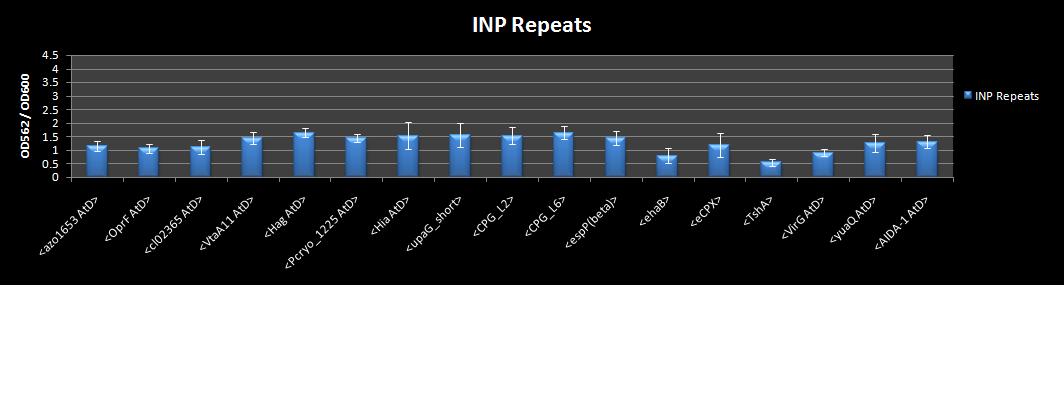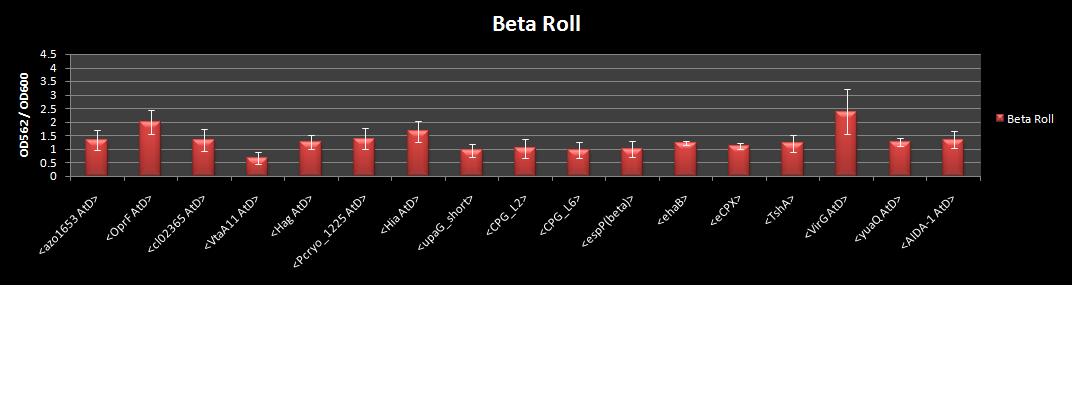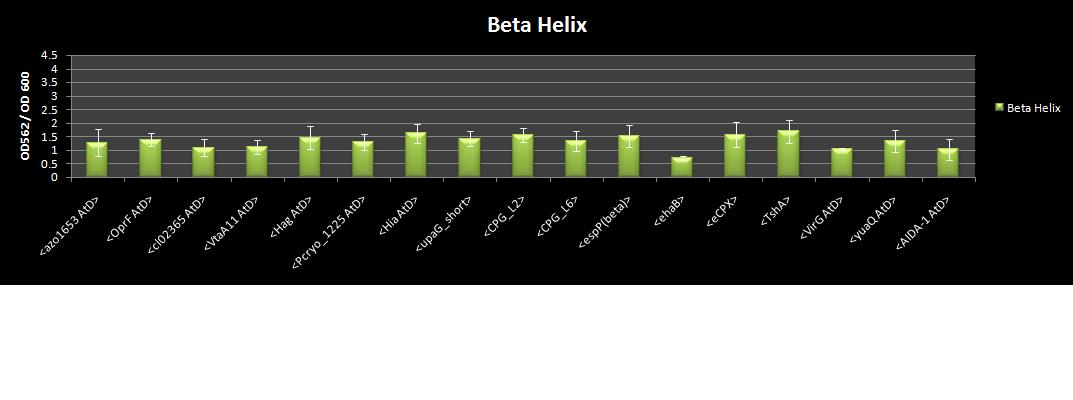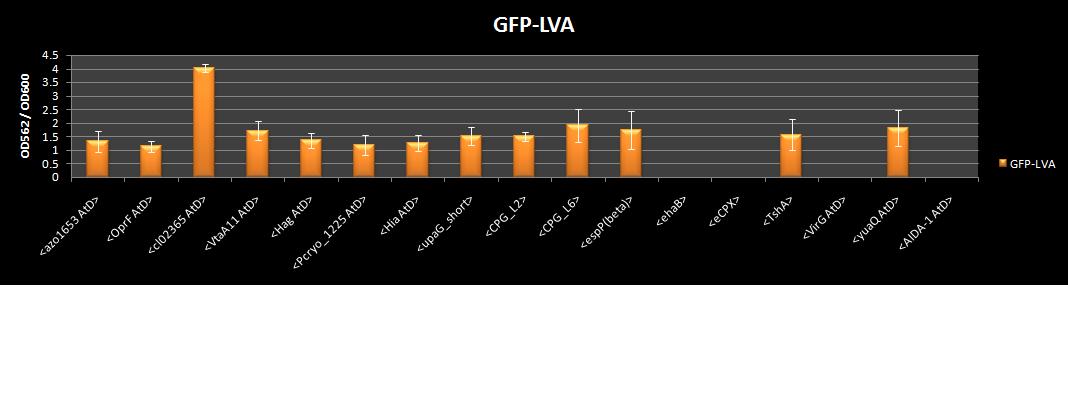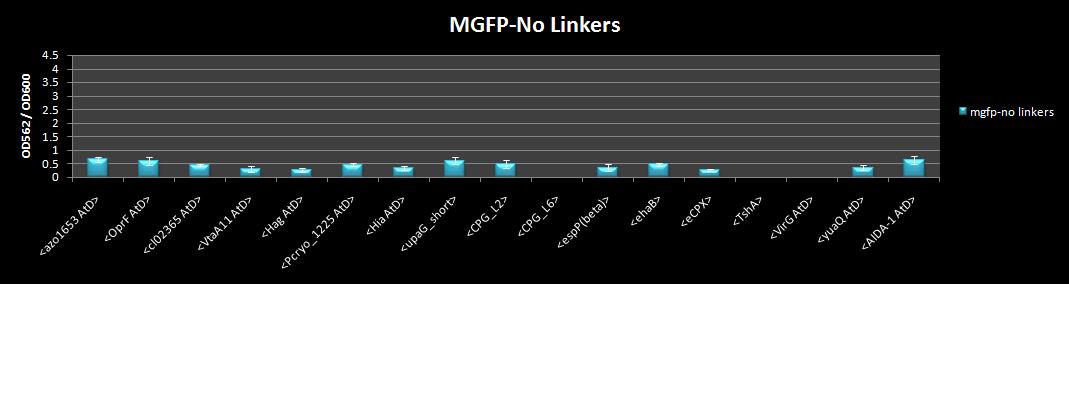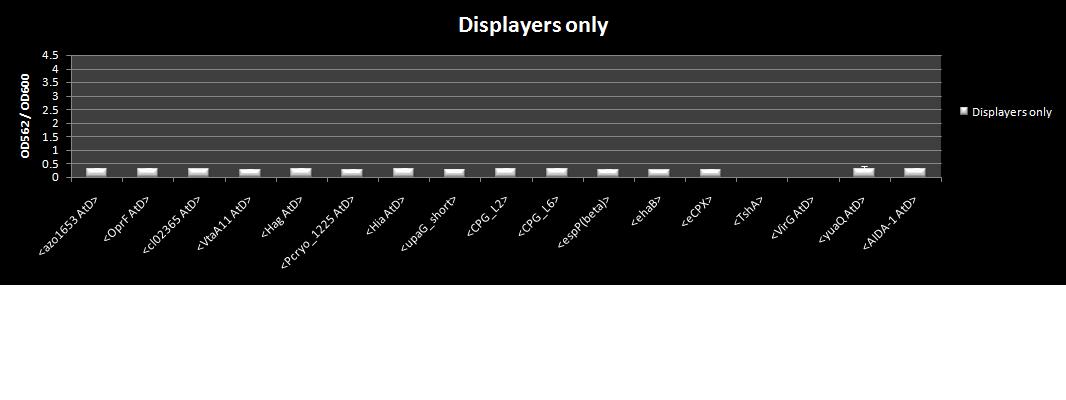Team:Berkeley Wetlab/Passenger: MGFP
From 2009.igem.org
Mussel Adhesive Protein
Mgfp-5 is a recombinant mussel adhesive protein from M. galloprovincialis. In their natural marine environment, mussels produce and secrete special proteins that allow them to adhere to surfaces. Involved in this mechanism of attachment, mgfp-5 has been shown to possess significant adhesive properties, making it an ideal candidate for underwater and medical applications. We attempted to express mgfp-5 on the surface of E. coli as a means of developing an inexpensive, eco-friendly bioadhesive. We designed and examined mgfp-5 display systems both included and exculded spacer elements. The results suggested that spacers enhance functional surface display of proteins.
Functional Assay: BCA Protein Quantification Assay
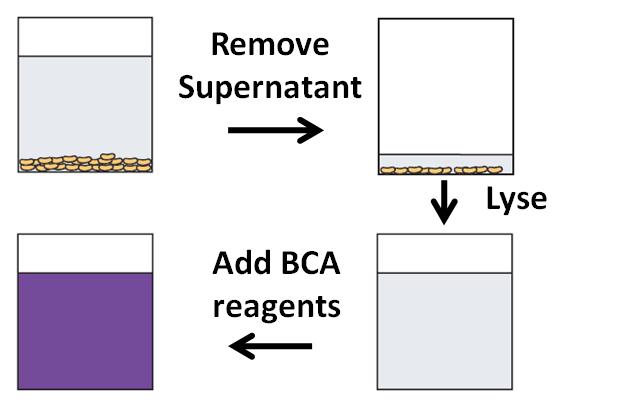
This assay tests for the presence of mgfp-5 displayed on the surface of E. coli through its ability to bind to the bottom of polystyrene plates.
Constructs used:
- mgfp-5 + spacers + displayers (79)
- mgfp-5 + displayers (14)
- displayers only (15)
Experiment run with 5x replicate of each condition
Day 1: Grow Cells
- Pick cells, using pin tool, with appropriate constructs from frozen stock plates into 96-well blocks with 1 ml of LB+AC media
- Place blocks in 37C shaker overnight to grow to saturation
Day 2: Induce Cells
- Set up 96-well blocks with 1 ml of LB+AC+arabinose media: Add 1 ul of arabinose at a concentration of (100mg/ml) to one ml of LB+AC media (1: 1000)
- Take plates with constructs out of the 37C incubator and add 10 ul of each construct to the LB+AC+arabinose media to induce
- Incubate blocks at 37C in shaker overnight.
Day 3: Incubate in Artificial Seawater
- Remove blocks from incubator
- Pellet cells at 5400 rpm for 7 minutes
- Remove supernatant by flicking block over a sink (swiftly inverting block in one motion)
- Re-suspend cells in 100 ul of artificial seawater
- Transfer 50 ul of cell suspensions with multi-pipette to labeled flat bottom 96-well costar plates (polystyrene plates)
- Take OD 600 readings in TECAN
- Cover plates with plastic film and let cells settle overnight
Day 4: Run BCA Protein Quantification Assay
- Uncover plates and flick out the liquid from each plate over a sink.
- Wash each plate with 100 ul of artificial seawater (using dispense 100 ul program on the washing robot)
- Flick out liquid again (this should remove the cells that are unbound to the surface of the polystyrene plates)
- Add 25 ul of Tris buffer + 2% SDS to each well, to lyse cells
- Set up BCA standards in empty wells on the plates for each condition replicate: 0.25, 0.75 and 1.0 mg of bovine serum albumin(BSA)/ ml of Tris Buffer + 2% SDS
- Incubate plates at 50C for 15 minutes
- While plates are incubating, set up another set of flat-bottom polystyrene plates with 190 ul of BCA reagents for each construct: BCA reagents are (1:50 ratio of BCA reagent (A) little blue bottle : (B) big white bottle.
- Remove plates from incubator and transfer 10 ul of each lysate to the corresponding well in the plates with the BCA reagents.
- Incubate plates for 40 minutes at 37C
- Take OD 562 measurements on the TECAN
- Analyze Data
Results
MGFp-5 + Linkers data
The raw data and excel file used for analysis may be viewed in the September 30th entry
Link to notebook entry: [http://openwetware.org/wiki/Lab_Notebook_-_Gabriela#September_30th Gabriela's entry September 30th]
INP-Repeats
Graph of the mean OD562 signals normalized to OD600 data:
Beta Roll
Beta Helix
Gly-Ser Repeats
GFP-LVA
MGFP - no linkers data
Displayers only data
Resulting signals from displayers only were indicative of background adhesion of cells to polystyrene plates. The OD562 signals were consistently lower that those of mgfp + linkers.
One-tailed t-test analysis
We performed some statistical analysis on the data collected to examine its significance. One-tailed t-tests were conducted comparing each mgfp-5 display system to its corresponding displayer-only construct. Those mgfp-5 samples that adhered significantly to the polystyrene plates in comparison to cells not expressing mgfp-5 were considered positive "hits", where the t-test p-value result was less than 0.02.
The chart below displays the calculated p-values for each construct examined. It is interesting to note that the increase in successful functional display increased from ~50% without spacers, to almost 100% with spacers, suggesting the importance of the inclusion of spacers in systems of surface display.
Conclusions
After conducting the statistical analysis on the mgfp-5 constructs, an interesting trend was made evident. The inclusion of spacer elements between the displayer and passenger (mgfp-5) greatly increased the percentage of successful surface display. Without spacer elements the hit rate was approximately 50%, whereas with spacers the hit rate increased to almost 100%. This shows promise for including spacer elements in surface display design, especially for passengers that are difficult to display on their own.
References
Dong Soo Hwang et al. Expression of Functional Recombinant Mussel Adhesive Protein Mgfp-5 in Eschericia coli. American Society for Microbiology. June 2004; 70(6): 3352-3359. Available online at: http://www.ncbi.nlm.nih.gov/pmc/articles/PMC427802/
Dong Soo Hwang et al. Recombinant mussel adhesive protein Mgfp-5 as cell adhesion biomaterial. Journal of Biotechnology. January 2007; 127(4): 727-735. Available online at: http://www.sciencedirect.com/science?_ob=ArticleURL&_udi=B6T3C-4KXDR0V-2&_user=4420&_rdoc=1&_fmt=&_orig=search&_sort=d&_docanchor=&view=c&_searchStrId=1055355525&_rerunOrigin=scholar.google&_acct=C000059607&_version=1&_urlVersion=0&_userid=4420&md5=f42a3bf4ce27e18c7d1d4668a5374305
 "
"







